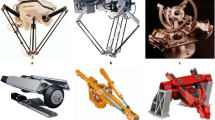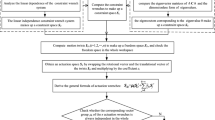Abstract
Type synthesis of lower-mobility parallel mechanisms is a hot and frontier topic in international academic and industrial field. Based on the Lie group theory, a displacement manifold synthesis method is proposed. For all the nine kinds of lower-mobility parallel mechanisms, the mechanism displacement manifold, limb displacement manifold and the geometrical conditions which guarantee that the intersection of the limb displacement manifold is the desired mechanism displacement manifold are enumerated. Various limb kinematic chains can be obtained using the product closure of displacement subgroup. Parallel mechanisms can be constructed with these limbs while obeying the geometrical conditions. Hence, all the nine kinds of lower-mobility parallel mechanisms can be synthesized using this method. Since displacement manifold deals with finite motion, the result mechanism of synthesis have full-cycle mobility. Novel architectures of lower-mobility parallel mechanisms can be obtained using this method.
Similar content being viewed by others
References
Hunt, K. H., Structural kinematic of in-parallel-actuated robot arms, Journal of Mechanisms, Transmissions and Automation in Design, 1983, 105: 705–712.
Clavel, R., A fast robot with parallel geometry, in Proceedings of the 18th International Symposium on Industrial Robots, Sydney, 1988, 91–100.
Hervé, J. M., Sparacino, F., Structural synthesis of parallel robots generating spatial translation, in Proceedings of the 5th IEEE Int. Conference on Advanced Robotics, Pisa, 1991, 808–813.
Tsai, L. W., Kinematics of a three-dof platform with extensible limbs, in Recent Advances in Robot Kinematics (eds. Lenarčič, J., Parenti-Castelli, V.), Dordrecht: Kluwer Academic Publishers, 1996, 401–410.
Pierrot, F., Company, O., H4: a new family of 4-dof parallel robots, in Proceedings of IEEE/ASME International Conference on Advanced Intelligent Mechatronics, Atlanta, 1999, 508–513.
Zhao, T. S., Huang, Z., Theory and application of input selection of insufficient rank spatial parallel manipulators, Chinese Journal of Mechanical Engineering, 2000, 36(10): 81–85.
Zlatanov, D., Gosselin, C. M., A new parallel architecture with four degrees of freedom, in Proceedings of the 2nd Workshop on Computational Kinematics, Seoul, 2001, 57–66.
Tsai, L. W., The enumeration of a class of three-dof parallel manipulators, in Proceedings of the Tenth World Congress on the Theory of Machines and Mechanisms, Finland, 1999, 1123–1126.
Hervé, J. M., Analyse structurelle des mécanismes par groupe des déplacements, Mechanism and Machine Theory, 1978, 13: 437–450.
Karouia, M., Hervé, J. M., A family of novel orientational 3-dof parallel robots, in Proceedings of the Ro. Man. Sy 2002, 14th CISM-IFToMM Symposium, Udine, 2002, 359–368.
Yang, T. L., Jin, Q., Liu, A. X. et al., A general method for structural synthesis of the degenerate-rank parallel robot mechanisms based on the units of single-opened-chain, Mechanical Science and Technology, 2001, 20(3): 321–325.
Merlet, J. P., Parallel robot: open problems, in Proceedings of the 9th Int. Symp. of Robotics Research, Snowbird, 1999, 9–12.
Merlet, J. P., Parallel Robots, Dordrecht: Kluwer Academic Publishers, 2000.
Huang, Z., Li, Q. C., Type synthesis principle of minor-mobility parallel manipulators, Science in China (Series E), 2002, 45(3): 241–248.
Huang, Z., Li, Q. C., General methodology for type synthesis of lower-mobility symmetrical parallel manipulators and several novel manipulators, International Journal of Robotics Research, 2002, 21(2): 131–145.
Huang, Z., Li, Q. C., Type synthesis of symmetrical lower-mobility parallel mechanisms using constraint-synthesis method, International Journal of Robotics Research, 2003, 22(1): 59–79.
Huang, Z., Li, Q. C., Decoupled five degrees of freedom fully-symmetrical parallel mechanism, Chinese invention patent. No. ZL01122274.3.
Author information
Authors and Affiliations
Corresponding author
Rights and permissions
About this article
Cite this article
Li, Q., Huang, Z. & Hervé, J.M. Displacement manifold method for type synthesis of lower-mobility parallel mechanisms. Sci. China Ser. E-Technol. Sci. 47, 641–650 (2004). https://doi.org/10.1360/03ye0352
Received:
Issue Date:
DOI: https://doi.org/10.1360/03ye0352




